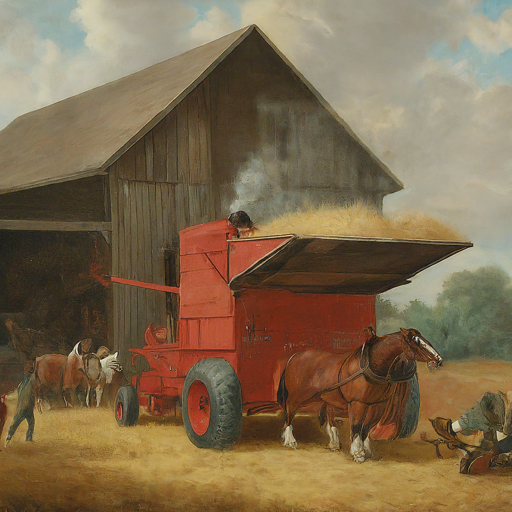The tractor thresher, a powerful and versatile machine, stands as a testament to human ingenuity in revolutionizing agriculture. Once a laborious task performed by hand, threshing is now accomplished with remarkable efficiency thanks to these remarkable implements. Let’s delve into the world of tractor threshers, exploring their history, operation, and impact on modern farming practices.
A Historical Threshing:

- Early Days: For millennia, threshing grain involved manual methods like beating stalks with flails or treading them underfoot by animals. This backbreaking work was time-consuming and limited productivity.
- The Threshing Machine Revolution: The 18th century saw the invention of the threshing machine, a horse-powered device that utilized rotating drums to separate grain from chaff. This marked a significant advancement, but widespread adoption was hampered by its cost and complexity.
- The Rise of the Tractor Thresher: The 20th century ushered in the era of the tractor, and with it, the tractor thresher. These machines, powered by tractors through the Power Take-Off (PTO) shaft, offered greater efficiency and portability, making them accessible to a wider range of farmers.
Anatomy of a Thresher:
-
Feeding Mechanism: The thresher’s maw, often a conveyor belt or auger, ingests the harvested crop.
-
Threshing Unit: The heart of the thresher, this chamber employs various mechanisms like rotating drums, rasp bars, and sieves to separate grain from stalks and chaff.
-
Cleaning Unit: This section refines the separation process, removing dust, broken straw, and other impurities from the grain.
-
Grain Discharge: The final stage, where the clean grain is deposited into a trailer or storage bin.
The Thresher’s Impact:

- Increased Productivity: Tractor threshers significantly reduced the time and labor required for threshing, allowing farmers to cultivate larger areas and harvest more crops.
- Improved Grain Quality: The controlled threshing process minimized damage to the grain, leading to higher quality and better market value.
- Reduced Labor Costs: Replacing manual labor with mechanized threshing lowered production costs, making agriculture more economically viable.
Beyond the Basics:
-
Modern Threshers: Today’s tractor threshers are marvels of engineering, featuring advanced features like adjustable settings for different crops, automated controls, and even self-propelled models.
-
Multicrop Threshers: These versatile machines can handle a wide range of crops, from wheat and rice to corn and soybeans, eliminating the need for multiple specialized threshers.
-
Sustainable Practices: Modern threshers are designed with efficiency and environmental consciousness in mind, minimizing waste and fuel consumption.
Conclusion:
The tractor thresher has transformed agriculture, enabling farmers to produce more food with less effort and resources. As technology continues to evolve, these machines will undoubtedly play an even greater role in ensuring food security for a growing population.


